Water/Wastewater
Can Microplastics Be Eliminated from Wastewater?
Feb 19 2021
A new study conducted by scientists from the National Institute of Scientific Research (INRS) in Quebec, Canada suggests that microplastics could be entirely eliminated from wastewater treatment processes. Using a technique known as electrolytic oxidation, the team were able to completely remove microplastics at source, without the introduction of any damaging chemicals or additives.
If the discovery can be demonstrated to be effective outside of a laboratory environment, it could represent a major breakthrough in treating wastewater contaminated with microplastics. At present, there are no established methods of degrading microplastic particles in even the most novel and sophisticated wastewater treatment methods. As such, the INRS study could be invaluable in preventing countless microplastics from entering our seas, oceans and other waterways.
Existing techniques not up to scratch
All current efforts to reduce the amount of microplastics which escape wastewater treatment facilities focus upon physical separation of the particles, rather than their degradation. This solution is only half-effective in that it does not solve the problem completely, but rather creates a new one in the shape of dealing with the microplastic particles after they have been separated. In fact, there have been very few studies conducted into the possibility of degrading microplastics rather than filtering them.
The INRS study attempted to right that wrong by looking at how electrolytic oxidisation could be used to treat the particles. Instead of using chemical additives – which can place a great environmental burden on the planet – the team opted to generate hydroxyl radicals via the use of electrodes. Rather than filtering the particles or simply converting them into airborne microplastics – the health effects of which are not yet fully understood – the process simply converts them into non-toxic carbon and water molecules.
Impressive early results
The lab-based tests conducted by the INRS researchers showed highly encouraging results. They not only observed electrolytic oxidisation degrading over half of the microplastics samples in less than an hour, but they were instantly converted into gas, rather than simply being broken down into smaller constituent parts. In the most positive results, water that contained fragments of polystyrene saw 89% of the microplastics contained within it destroyed by the process.
The team behind the study are hopeful that their discovery can be helpful in removing microplastics at the source, rather than simply being employed at wastewater treatment facilities. Commercial laundromats are a chief contributor of microplastics, for example, since tiny fragments are released from clothing articles during the washing process. By implementing electrolytic oxidisation here, the technique will target a higher concentration of microplastics and eliminate the issue long before it develops into a really concerning one. Although further tests in a real-life laundromat environment are now required, the initial signs are positive that the INRS team could have struck upon a major breakthrough in the fight against microplastic pollution.
Digital Edition
AET 28.2 April/May 2024
May 2024
Business News - Teledyne Marine expands with the acquisition of Valeport - Signal partners with gas analysis experts in Korea Air Monitoring - Continuous Fine Particulate Emission Monitor...
View all digital editions
Events
Jul 10 2024 Birmingham, UK
Jul 21 2024 Cape Town, South Africa
Australasian Waste & Recycling Expo
Jul 24 2024 Sydney, Australia
Jul 30 2024 Jakarta, Indonesia
China Energy Summit & Exhibition
Jul 31 2024 Beijing, China


















